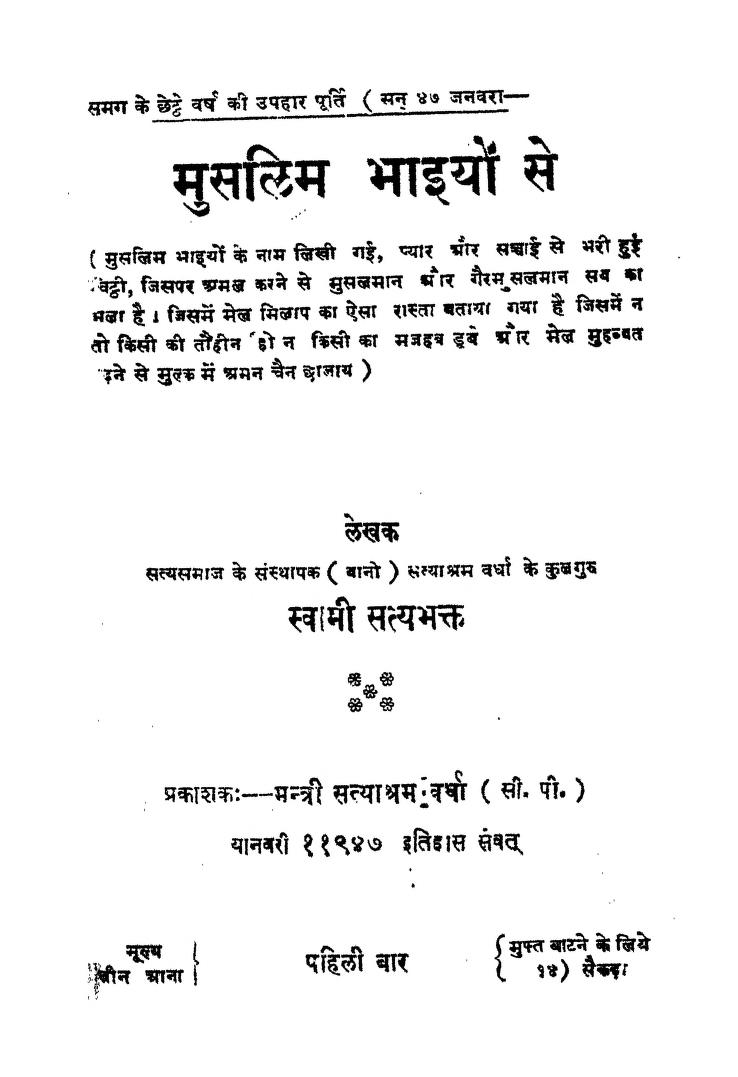Saquib Salim
Swami Satyabhakta was a 20th-century Indian philosopher who represented Jain and Hindu religious thoughts to promote love among humans. In the late 1940s when India witnessed one of the worst communal riots leading to the partition of the country, Satyabhakta, with his followers, preached love.
A Slice Of History
He printed and distributed booklets with the message that the Hindu-Muslim antagonism is artificial. His ideas are relevant even today in an environment where people face religion-based discrimination. His thoughts influenced thousands of Indians in the darkest of times.
Satyabhakta told people, “Such conflicts are not alien to this country. In the past Aryans and non-Aryans were in a much bitter conflict because their cultures differed in many more ways than those of Hindus and Muslims. Today that conflict doesn’t exist anymore and both live as one society and a nation.”
Satyabhakta listed points of differences between Hindus and Muslims which were blamed for violence and then countered those one by one.
The cover of the booklet published by Swani Satyabhakta
Muslims see idol worship by Hindus in a way that creates conflict between the two communities. Satyabhakta explains, “There are many sects among Hindus like Arya Samaji, Brahmo Samaji, Sthanakvasi, etc. who are against idol worship. Sikhs and Taranpanthis are half idol worshipers, that is, they worship the scriptures as idols and Muslims are also half idol worshipers, they worship Taziya and graves, kiss the stone of Kaaba, it is forbidden to wear shoes in the mosques, these are also a kind of idol worship, respect for brick and limestone is also idol worship, hence both Hindus and Muslims are idol worshippers. In reality, neither a Hindu is an idol worshipper nor a Muslim.”
He said that the anti-idol campaign of the Prophet was a reply to those who made people fight in the name of idols. Followers of one idol would take up arms against the followers of the other. This was an attempt to unify people and that was how he campaigned against the idols. In the present context, India must overlook such differences to achieve unity.
Satyabhakta said, “In practice, even among Hindus there are idol worshipers and its opponents and among Muslims too there are idol worshipers and its opponents.”
Eating meat is another perceived point of conflict. Satyabhakta argued, “Seventy-five out of every hundred Hindus are meat-eaters. Most of the castes called Shudra are meat eaters in Bengal, Orissa, Mithila, and other provinces, the so-called upper caste including Brahmins, etc. also eat meat. Kshatriya people mostly eat meat. Sikhs eat meat and Christians also eat meat, hence meat eating cannot be said to be the reason for discrimination between Hindus and Muslims.”
It is also said that Hindus are polytheists and Muslims are monotheists therefore they cannot live together in peace. Satyabhakta says, “Hindus believe in multiple gods (avatars) but are not polytheists. Like Muslims, they are also monotheistic and like Hindus, Muslims are also believers in several messengers. Hindus believe in only one God and believe in many of his incarnations, personalities, messengers, etc., thus in different forms. They worship only one God. Muslims believe in thousands of prophets of the same God and respect them. Just as God is one despite having thousands of prophets, God is one despite having thousands of servants and devotees as incarnations.”
Several Hindu sects do not even believe in any God and yet they are accepted as such. So, the idea that monotheism and polytheism cause the conflict between Hindus and Muslims is unfounded.
A stamped picture of Swami Satyabhakta in his younger days
A major point of conflict is that Muslims allege that Hindus play loud music in front of mosques while music is prohibited in Islam. Satyabhakta argues, “Ethics say that if Namaz is being offered and Thakurji's procession comes out with musical instruments, then the procession should stop as soon as it comes in front of the Masjid and all the people should stand peacefully as if they have participated in the Namaz.
“After namaz is over, Muslims should ensure the procession proceeds respectfully. If the procession arrives just before the Namaz, then after giving a respectful farewell to the procession, the Muslims should offer the Namaz. Delaying Namaz by 10-5 minutes causes no harm.”
Satyabhakta argued similarly that the conflicts of nationality, language, script, and dress are also artificial. If examined closely both communities overlap so much that at times they are indistinguishable.
Hindus and Muslims, he believed, should pray with each other occasionally. Satyabhakta said, “Those who offer namaz every day should sometimes enjoy the puja in Hindu style. Similarly, those doing puja every day should try offering namaz. When we try new tastes in food, why don’t we try new ways to attain spiritual goals? These new tastes will be beneficial for love, peace, and humanity.”
Satybhakta also addressed another perceived difference - Hindus look west and Muslims east while praying. He said this proves that the two communities are knitted together.
He says, “It is necessary to look in opposite directions while meeting or talking. Even if I turn to face the direction you are facing, you will look at my back, what would you do if I want to meet you chest to chest, then I will face the opposite direction from where you are facing, otherwise we will not meet. When it is necessary to face each other in the opposite direction to meet, then why should the opposite direction become a hindrance in meeting for worship and namaz?”
.webp)


